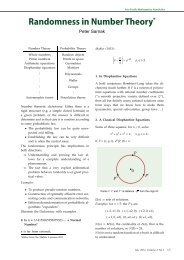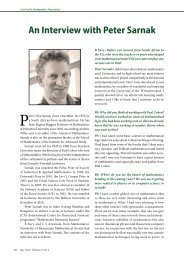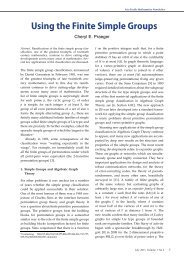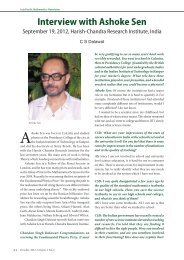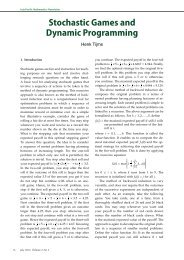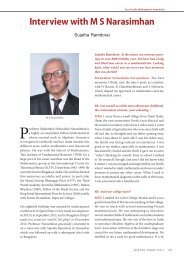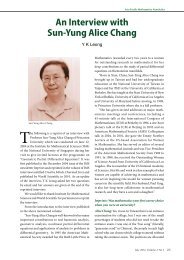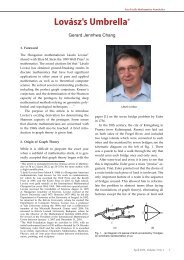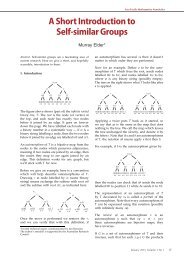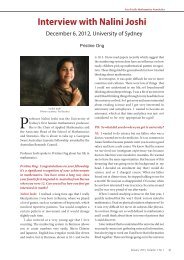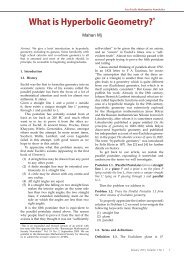Benford's Law of First Digits - Asia Pacific Math Newsletter
Benford's Law of First Digits - Asia Pacific Math Newsletter
Benford's Law of First Digits - Asia Pacific Math Newsletter
Create successful ePaper yourself
Turn your PDF publications into a flip-book with our unique Google optimized e-Paper software.
Malcolm Sambridge, Hrvoje Tkalčić and Pierre Arroucau<br />
<strong>Asia</strong> <strong>Pacific</strong> <strong>Math</strong>ematics <strong>Newsletter</strong><br />
1<br />
Benford’s <strong>Law</strong> <strong>Law</strong> <strong>of</strong> <strong>First</strong> <strong>of</strong> <strong>First</strong> <strong>Digits</strong>: <strong>Digits</strong>: From<br />
From <strong>Math</strong>ematical Curiosity Curiosity to to<br />
Detector<br />
Change Detector<br />
Malcolm Sambridge, Hrvoje Tkalčić and Pierre Arroucau<br />
More than 100 years ago it was predicted that the<br />
distribution <strong>of</strong> first digits <strong>of</strong> real world observations<br />
would not be uniform, but instead follow a trend where<br />
measurements with lower first digit (1,2,...) occur more<br />
frequently than those with higher first digits (...,8,9).<br />
This result has long been known by mathematicians<br />
but regarded as mere mathematical curiosity. In the<br />
physical sciences awareness <strong>of</strong> Benford’s law, as it<br />
became known, has been slow to spread. Recently the<br />
list <strong>of</strong> phenomena which follow the predictions <strong>of</strong> the<br />
law has expanded, and physical scientists have begun<br />
to find new ways to put it to practical use.<br />
Major scientific discoveries have <strong>of</strong>ten resulted<br />
from the chance recognition <strong>of</strong> a pattern or trend<br />
in observations. In 1854 J. Snow noticed how<br />
cholera patients had all been drinking from the<br />
same water pump in London [1]. The recognition<br />
<strong>of</strong> a pattern in data led to the discovery that<br />
cholera spread through contaminated drinking<br />
water, even though bacteria and viruses were<br />
unknown at the time [2]. That breakthrough later<br />
led Louis Pasteur to formulate the theory <strong>of</strong> germs<br />
which helped lay the foundations <strong>of</strong> modern microbiology.<br />
Another example is the discovery in<br />
1936 <strong>of</strong> Earth’s inner core by Inge Lehmann [3].<br />
Lehmann noticed something anomalous in the<br />
seismic recordings <strong>of</strong> distant earthquakes. Energy<br />
in the form <strong>of</strong> two new seismic phases were<br />
observed at the surface in places where there<br />
should only be energy <strong>of</strong> PKP waves propagating<br />
through the liquid outer core. This turned out to<br />
be the first observation <strong>of</strong> new seismic phases that<br />
could only have been caused by the presence <strong>of</strong> a<br />
solid inner core. In both cases unexpected patterns<br />
seen in observations led to major discoveries.<br />
Today observations are collected at rates never<br />
before seen, and scientists are constantly seeking<br />
new automated ways to detect subtle signals<br />
and extract information from massive data<br />
streams. Examples include experiments to unravel<br />
the basic forces shaping the universe, e.g. the<br />
search for the elusive Higgs particle in the Large<br />
Hadron Collider [4]; detection <strong>of</strong> gravity waves<br />
[5]; discovery <strong>of</strong> new drugs [6] and analysis <strong>of</strong> the<br />
human genome [7]. Recent work by geophysicists<br />
[8] has suggested that an intriguing pattern in<br />
data, first proposed more than 100 years ago, may<br />
provide a new way to detect change in physical<br />
phenomena. The pattern in question is known as<br />
the first digit, or Benford’s law, which itself has<br />
been discovered, forgotten and rediscovered over<br />
the past century.<br />
In this article we briefly introduce the phenomenon,<br />
provide some theoretical insight, outline<br />
recent developments and conclude with the<br />
suggestion that analysis <strong>of</strong> digits may provide<br />
a novel way <strong>of</strong> detecting subtle change in data<br />
trends across the physical sciences.<br />
1. A Brief History <strong>of</strong> the <strong>First</strong> Digit<br />
Phenomenon<br />
In the 19th century the astronomer Newcomb [9]<br />
first noticed that library books <strong>of</strong> logarithms were<br />
more thumbed in the earlier pages than the latter.<br />
He explained how this could arise if the frequency<br />
<strong>of</strong> first digits themselves were not uniform in real<br />
world observations but rather followed the rule<br />
(<br />
P D = log 10 1 + 1 )<br />
(1)<br />
D<br />
where P D is the probability <strong>of</strong> first (nonzero) digit<br />
D occurring (D = 1, ..., 9). For example, the real<br />
numbers 123.0 and 0.016 both have D = 1, and the<br />
digit law suggests that numbers beginning with<br />
a 1 will occur about 30% <strong>of</strong> the time in nature,<br />
while those with a first digit <strong>of</strong> 2 will occur about<br />
17% <strong>of</strong> the time, and so on down to first digits <strong>of</strong><br />
9 occurring about 4% <strong>of</strong> the time. This decreasing<br />
trend <strong>of</strong> probabilities with digit is represented<br />
pictorially in Fig. 1, together with some modern<br />
data sets that appear to follow it. The implications<br />
October 2011, Volume 1 No 4 1
<strong>Asia</strong> <strong>Pacific</strong> <strong>Math</strong>ematics <strong>Newsletter</strong><br />
2<br />
may provide a novel way <strong>of</strong> testing realism in<br />
mathematical models <strong>of</strong> physical processes [12].<br />
If quantities associated with those processes are<br />
known to satisfy BL then computer simulations<br />
<strong>of</strong> them should do also. More recently BL has<br />
been shown to hold in stock prices [13] and some<br />
election results [14].<br />
2. Theoretical Insight<br />
Fig. 1. Benford’s law predictions according to (1) for distributions<br />
<strong>of</strong> 1st digits compared to the three data sets, (i) photon fluxes for<br />
1452 bright objects identified by the Fermi space telescope, (ii)<br />
248,915 globally distributed earthquakes in the period 1989–<br />
2009, and (iii) 987 reports <strong>of</strong> infectious disease numbers to<br />
World Health Organisation in 2007. Data from [8]. The 1st digit<br />
distributions from a wide variety <strong>of</strong> data sets appear to fit the<br />
predictions <strong>of</strong> the 1st digit law well. [Figure courtesy <strong>of</strong> Rhys<br />
Hawkins, ANU Visualisation laboratory.]<br />
<strong>of</strong> the digit rule are significant as not only is<br />
the distribution not uniform, implying that digit<br />
frequencies are not independent, but it must also<br />
hold irrespective <strong>of</strong> the units <strong>of</strong> the data and their<br />
source. Hence a universal property <strong>of</strong> real world<br />
measurements. The result was rediscovered in<br />
1938 by an engineer called Benford [10]. Benford<br />
also extended the law to arbitrary base, B, and to<br />
multiple digits, N. In this case (1) becomes<br />
(<br />
P D = log B 1 + 1 )<br />
(2)<br />
D<br />
where the number <strong>of</strong> possibilities for D depends<br />
on both B and N and we have B N−1 ≤ D ≤ B N −<br />
1. For example, for two digits N = 2 and there<br />
are 90 possibilities for D, i.e. D = 10, 11, ..., 99.<br />
As the number <strong>of</strong> digits increases the probability<br />
distribution becomes flatter and more uniform.<br />
In his original paper Benford showed that<br />
20,229 real numbers drawn from 20 sources all<br />
approximately followed the same first digit rule.<br />
These included populations <strong>of</strong> cities, financial<br />
data and American baseball league averages. Benford’s<br />
results were well known in mathematical<br />
circles and despite a waning <strong>of</strong> interest his name<br />
became associated with the law. Thirty years<br />
later the same first digit distribution was noticed<br />
in numbers encountered in computer registries<br />
[11]. This led to the suggestion that advanced<br />
knowledge <strong>of</strong> the digit frequency encountered by<br />
computers might be used to optimise their design.<br />
It has also been suggested that Benford’s law<br />
Theoretical insight into the origin and reasons for<br />
Benford’s law was provided by [15–17, 12]. It is<br />
known that BL is the only probability distribution<br />
which is both scale and base invariant, properties<br />
which such a rule must have to be universally<br />
applicable. By scale invariance it follows that if<br />
first digits <strong>of</strong> the variable x follow (1) then so will<br />
the first digits <strong>of</strong> the rescaled variable λx, for any<br />
value <strong>of</strong> λ. Since the Benford distribution is the<br />
only one with this property the converse is also<br />
true, i.e. if the first digits <strong>of</strong> x do not follow (1)<br />
then no rescaling will make them do so. Scale<br />
invariance can be used as a way to measure fit<br />
to the law <strong>of</strong> any infinite sequence <strong>of</strong> numbers<br />
[18]. The Fibbonacci sequence is a well known<br />
example, as are many geometric series x n = ar n<br />
and dynamical systems <strong>of</strong> the form x n+1 = x 2 n + 1<br />
[19].<br />
A second mathematical result is that even if<br />
individual distributions <strong>of</strong> real variables do not<br />
follow BL, random samples from those distributions<br />
will tend to follow BL, the so called Random<br />
samples from Random distributions theorem [17].<br />
Over the years there have been a number <strong>of</strong><br />
mathematical and statistical explanations put forward<br />
for Benford’s law. One <strong>of</strong> the earliest was by<br />
Feller in his classic 1971 statistical textbook [20],<br />
which was later challenged [21]. Recently Fewster<br />
[22] has put forward a particularly appealing one<br />
for the case <strong>of</strong> real valued quantities. In that<br />
study an experiment is carried out where the<br />
probability distribution with the worse possible<br />
fit to Benford’s law is solved for a given dynamic<br />
range <strong>of</strong> the deviates and smoothness <strong>of</strong> the PDF.<br />
Numerical results show that it becomes increasingly<br />
difficult for deviates to fail a goodness <strong>of</strong> fit<br />
test with respect to fitting Benford as smoothness<br />
<strong>of</strong> the PDF increases [22]. At the same time other<br />
mathematicians have put forward arguments that<br />
smoothness <strong>of</strong> a PDF alone does not guarantee<br />
adherence to Benford’s law [21]. For integer se-<br />
2<br />
October 2011, Volume 1 No 4
<strong>Asia</strong> <strong>Pacific</strong> <strong>Math</strong>ematics <strong>Newsletter</strong><br />
3<br />
quences the origin <strong>of</strong> Benford’s law is less well<br />
developed and indeed there appears to be no<br />
single explanation that covers all cases [21].<br />
2200<br />
2000<br />
1800<br />
1600<br />
Fit to Benford<br />
Fit to finite range Benford<br />
3. Finite Range Real Numbers<br />
One aspect that appears to have received little<br />
attention is the influence <strong>of</strong> the finite range <strong>of</strong><br />
the data on adherence to Benford’s law. It is<br />
known that Benford’s law <strong>of</strong> digits will result if<br />
the random deviates have a log-uniform modulo<br />
1 distribution. For real valued random deviates<br />
that span a single decade, i.e. 1 < x < 10, and<br />
have PDF P(x) we have,<br />
P D =<br />
D+1<br />
D<br />
10<br />
1<br />
i=1<br />
P(x)dx<br />
. (3)<br />
P(x)dx<br />
If the PDF <strong>of</strong> the random deviates has a loguniform<br />
distribution or equivalently P(x) ∝ 1/x<br />
we have<br />
[ln x]D+1<br />
D<br />
P D = = ln <br />
1 + 1 D<br />
(4)<br />
[ln x] 10 ln 10<br />
1<br />
which reduces to (1) and hence Benford’s law is<br />
recovered. For the case where the deviates span<br />
multiple decades, i.e. 10 α ≤ x ≤ 10 β and β>α+ 1<br />
the above integral becomes<br />
P D = 1 β−α<br />
(D+1)10 α+i−1<br />
1<br />
dx (5)<br />
C α, β D×10 α+i−1 x<br />
where the normalising constant, C α, β , is obtained<br />
by integrating the probability density over the<br />
whole range<br />
10 β<br />
1<br />
C α, β = dx = (β − α) ln 10. (6)<br />
10 α x<br />
Evaluating these integrals and combining shows<br />
that once again P D reduces to (1) and hence Benford’s<br />
law is recovered. Therefore the probability<br />
<strong>of</strong> occurrence <strong>of</strong> each digit is unchanged when<br />
the data range extends over an integer number <strong>of</strong><br />
decades. The situation changes however for the<br />
most general case <strong>of</strong> arbitrary limits, a × 10 α ≤<br />
x ≤ b × 10 β . In this case the integral range can<br />
be separated into three contributions, the first for<br />
the lower end <strong>of</strong> the range a × 10 α ≤ x ≤ 10 α+1 , the<br />
second for the decadal range, 10 α+1 ≤ x ≤ 10 β ,<br />
and the third for the upper non-decadal part<br />
10 β ≤ x ≤ b × 10 β . Evaluating each <strong>of</strong> these gives<br />
the generalisation <strong>of</strong> Benford’s law to arbitrary<br />
range log-uniform random deviates<br />
P D = 1 <br />
<br />
(β − α − 1) log<br />
λ 10 1 + 1 <br />
+ λ a + λ b (7)<br />
c D<br />
Chi-square fit<br />
1400<br />
1200<br />
1000<br />
800<br />
600<br />
400<br />
200<br />
0<br />
1 2 3 4 5 6 7 8 9 10<br />
Coefficient <strong>of</strong> data maximum (b)<br />
Fig. 2. Chi-square fit <strong>of</strong> first digit distributions to Benford predictions<br />
(black dots) given by (1) and the finite range theory (blue<br />
dots) given by (7) for 1000 sets <strong>of</strong> random deviates. The x axis<br />
is the upper coefficient b, the lower coefficient a = 1 and each<br />
data set has 10 5 deviates spanning three orders <strong>of</strong> magnitude,<br />
β − α = 3.<br />
where<br />
and<br />
λ c = (β − α) + log 10<br />
b<br />
a<br />
<br />
(8)<br />
⎧ <br />
log 10 1 +<br />
1<br />
D<br />
: D > a 1<br />
⎪⎨ <br />
λ a = log 1+D<br />
10 a<br />
: D = a 1 (9)<br />
⎪⎩ 0 : D < a 1<br />
⎧<br />
⎪⎨<br />
λ b =<br />
⎪⎩<br />
0 : D > b 1<br />
<br />
log b<br />
10 D<br />
: D = b 1<br />
<br />
: D < b 1 .<br />
log 10<br />
<br />
1 +<br />
1<br />
D<br />
(10)<br />
Here a 1 is the first digit <strong>of</strong> a and b 1 is the first digit<br />
<strong>of</strong> b. At first sight this looks more complicated<br />
than the original Benford’s law (1) but in fact it<br />
is no more difficult to evaluate. As we would<br />
expect (7)–(10) reduces to (1) when a = 1 or 10,<br />
and b = 1 or 10, and also as the dynamic range<br />
tends to infinity (β−α →∞). By following similar<br />
arguments to that above (7) may be extended to<br />
the most general case <strong>of</strong> multiple digits (rather<br />
than one) and an arbitrary base, B. The result<br />
is almost identical to (7) except that all base 10<br />
logarithms are replaced with logarithms in base<br />
B, and a 1 and b 1 are replaced with a n and b n<br />
indicating the first n digits <strong>of</strong> the data.<br />
Figure 2 shows results <strong>of</strong> a numerical experiment<br />
comparing the fit <strong>of</strong> 1000 sets <strong>of</strong> random<br />
deviates to both Benford predictions given by<br />
(1) and the finite range version (7). A statistical<br />
chi-square measure is used to test goodness <strong>of</strong><br />
fit <strong>of</strong> each first digit distribution to Benford law<br />
October 2011, Volume 1 No 4 3
<strong>Asia</strong> <strong>Pacific</strong> <strong>Math</strong>ematics <strong>Newsletter</strong><br />
4<br />
Frequency (%)<br />
35.0<br />
30.0<br />
25.0<br />
20.0<br />
15.0<br />
10.0<br />
5.0<br />
Benford law predictions<br />
Earthquake depths (km)<br />
Time interval between global earthquakes(s)<br />
Sumatra-Andaman seismogram<br />
masses <strong>of</strong> exoplanets, photon fluxes detected by<br />
the Fermi space telescope, as well as numbers <strong>of</strong><br />
infectious diseases reported to the World Health<br />
Organisation. Random subsets <strong>of</strong> these data were<br />
also shown to fit Benford’s law better than the<br />
original, which is consistent with predictions <strong>of</strong><br />
the random samples theory <strong>of</strong> Hill [12].<br />
5. Exploiting Benford’s <strong>Law</strong><br />
0.0<br />
0 1 2 3 4 5 6 7 8 9<br />
<strong>First</strong> digit<br />
Fig. 3. Histograms <strong>of</strong> first digit distributions <strong>of</strong> three properties<br />
<strong>of</strong> earthquakes. These include 248,915 depths <strong>of</strong> globally<br />
distributed earthquakes in the period 1989–2009 (source National<br />
Earthquake Information Center, United States Geological<br />
Survey), separation times in seconds <strong>of</strong> 2,258,653 global<br />
earthquakes, and 24,000 ground displacements measured on<br />
a seismometer in Peru over the first 20 minutes <strong>of</strong> the Sumatra-<br />
Andaman earthquake <strong>of</strong> 2004.<br />
predictions<br />
χ 2 =<br />
9∑ (n D − nP D ) 2<br />
, (11)<br />
nP D<br />
D=1<br />
where n D is the observed frequency <strong>of</strong> digit D and<br />
there are n data in total. As the data range changes<br />
the chi-square goodness <strong>of</strong> fit is extremely poor<br />
for the standard Benford law and only obtains<br />
the expected value <strong>of</strong> eight when the deviate<br />
range is a whole number <strong>of</strong> decades, b = 1 and<br />
10. In contrast the chi-square for the finite range<br />
prediction correctly fluctuates about the expected<br />
value <strong>of</strong> eight for all data sets. Similar trends are<br />
observed as the dynamic range <strong>of</strong> the data (β − α)<br />
are altered as well as number <strong>of</strong> deviates. In all<br />
cases, the predictions from (7) remain accurate.<br />
4. Empirical Evidence in the Natural<br />
Sciences<br />
Belatedly geophysicists have come across Benford’s<br />
law and performed their own survey to test<br />
its presence in the physical sciences [8]. It was<br />
found that a wide range <strong>of</strong> modern phenomena<br />
appears to follow the digit law. In particular<br />
over 750,000 real numbers drawn from the fields<br />
<strong>of</strong> Physics, Astronomy, Geophysics, Chemistry,<br />
Engineering and <strong>Math</strong>ematics. These include the<br />
rotation frequencies <strong>of</strong> pulsars; green-house gas<br />
emissions, atmospheric temperature anomalies,<br />
To date the most practical use anyone has found<br />
for Benford’s law is in a forensic mode, e.g. to detect<br />
fraud or rounding errors in real world numbers.<br />
This is possible by examining departures in<br />
the frequencies <strong>of</strong> individual digits from those<br />
predicted by Benford. This only makes sense once<br />
it is established (<strong>of</strong>ten empirically) that the data<br />
follow the law under normal circumstances. This<br />
has been exploited successfully to detect fraud in<br />
a range <strong>of</strong> situations involving financial data, such<br />
as business accounts, tax returns and stock market<br />
reports [23–25].<br />
The successes in forensic accountancy have<br />
inspired physical scientists to see whether similar<br />
ideas might be applied to detect signals in contrast<br />
to background noise, e.g. in time series data.<br />
Recently geophysicists showed that Benford’s law<br />
could be used to detect the onset <strong>of</strong> an earthquake<br />
from the frequencies <strong>of</strong> first digits <strong>of</strong> ground<br />
displacement counts recorded by a seismometer<br />
[8]. A summary <strong>of</strong> some collected results for digit<br />
distributions <strong>of</strong> earthquake properties is shown<br />
in Fig. 3 and includes their depth, time separation<br />
as well as displacements induced at the surface.<br />
Seismologists routinely identify and locate<br />
earthquakes using information from seismograms<br />
recorded at multiple locations across the globe.<br />
The ability to detect an earthquake from just the<br />
first digit histograms <strong>of</strong> seismic waveforms came<br />
as a surprise because most <strong>of</strong> the complex information<br />
contained in seismic waveforms would<br />
appear to have been removed when reducing the<br />
signal down to its first digit frequencies. Nevertheless<br />
the onset <strong>of</strong> an earthquake can clearly<br />
be manifested in the digit distribution alone. Inspired<br />
by this example, quantum physicists also<br />
applied Benford’s law to the detection <strong>of</strong> quantum<br />
phase transitions with apparent success [26].<br />
These examples show that analysis <strong>of</strong> digit<br />
frequencies has the potential to detect change<br />
in physical phenomena, which may lead to new<br />
4<br />
October 2011, Volume 1 No 4
<strong>Asia</strong> <strong>Pacific</strong> <strong>Math</strong>ematics <strong>Newsletter</strong> 5<br />
applications in the future. Seismologists have continued<br />
to examine the appearance <strong>of</strong> the digit<br />
law in their own field. A new data set that<br />
seems to follow Benford is the timing between<br />
earthquakes. Figure 3 shows results for over two<br />
million globally recorded earthquakes <strong>of</strong> all magnitudes<br />
and locations. The same result is achieved<br />
when earthquakes are divided into each magnitude<br />
range, except for the very large earthquakes<br />
(greater than magnitude eight) for which there<br />
are relatively few recorded in modern times. This<br />
result establishes a background trend for the digit<br />
frequencies <strong>of</strong> earthquake origin time separations.<br />
It raises the intriguing possibility that Benford’s<br />
law might have applications in the detection <strong>of</strong><br />
changes in the characteristics <strong>of</strong> earthquakes between<br />
regions, or over time. This may be an area<br />
for future exploitation.<br />
6. Concluding Remarks<br />
There is mounting evidence that Benford’s law <strong>of</strong><br />
first and later digit distributions may be a common<br />
feature across the physical sciences. While<br />
mathematicians will continue to seek theoretical<br />
justification for its existence, the challenge for<br />
physical scientists is to find new ways to exploit<br />
it. We argue that in situations where Benford’s<br />
law is observed to hold empirically, localised<br />
departures from it are tell-tale features <strong>of</strong> some<br />
other process at play, perhaps worthy <strong>of</strong> more<br />
detailed investigation. This is in essence the same<br />
argument used successfully in forensic accountancy.<br />
As awareness <strong>of</strong> this novel phenomenon<br />
grows among physical scientists it seems likely<br />
that further applications will appear.<br />
Over the years a large number <strong>of</strong> publications<br />
have appeared on aspects <strong>of</strong> Benford’s law across<br />
multiple disciplines. This can make it difficult for<br />
newcomers to the subject to appreciate the range<br />
<strong>of</strong> results already known. Fortunately many publications<br />
are now accessible in a single online bibliography<br />
http://www.benfordonline.net/<br />
which is a valuable resource for all.<br />
Acknowledgements<br />
We thank Andrew Jackson and Ted Hill for useful<br />
discussions, and Rachel Fewster for pointing out<br />
her article [22].<br />
References<br />
[1] I. F. Goldstein and M. Goldstein, The Experience <strong>of</strong><br />
Science (Plenum Press, New York, 1984).<br />
[2] R. Snieder and K. Larner, The Art <strong>of</strong> Being a Scientist:<br />
A Guide for Graduate Students and their Mentors<br />
(Cambridge Univ. Press, Cambridge, 2009).<br />
[3] I. P ′ . Lehmann, Publications du Bureau Central Seismologique<br />
International A14 (1936) S.87–115.<br />
[4] D. Clery, Bracing for a maelstrom <strong>of</strong> data, CERN<br />
puts its faith in the grid, Science 321 (2007) 1289–<br />
1291, doi: 10.1126/science.321.5894.1289.<br />
[5] B. P. Abbott et al., An upper limit on the stochastic<br />
gravitational-wave background <strong>of</strong> cosmological<br />
origin, Nature 460 (2009) 990–994.<br />
[6] W. L. Jorgensen, The many roles <strong>of</strong> computation<br />
in drug discovery, Science 303 (2004) 1813–1818,<br />
doi: 10.1126/science.1096361.<br />
[7] R. Lister et al., Human dna methylomes at base<br />
resolution show widespread epigenomic differences,<br />
Nature 462 (2009) 315–332, doi:10.1038/<br />
nature08514.<br />
[8] M. Sambridge, H. Tkalčić and A. Jackson, Benford’s<br />
law in the natural sciences, Geophys. Res.<br />
Lett. 37 (2010) L22301, doi:10.1029/2010GL044830.<br />
[9] S. Newcomb, Note on the frequency <strong>of</strong> use <strong>of</strong><br />
different digits in natural numbers, Amer. J. <strong>Math</strong>.<br />
4 (1881) 39–40.<br />
[10] F. Benford, The law <strong>of</strong> anomalous numbers, Proc.<br />
Am. Philos. Soc. 78 (1938) 551–572.<br />
[11] D. E. Knuth, The Art <strong>of</strong> Computer Programming, Four<br />
Volumes (Addison-Wesley, 1968).<br />
[12] T. P. Hill, The first-digit phenomenon, Amer. Sci.<br />
86 (1998) 358–363, doi: 10.1511/1998.4.358.<br />
[13] E. Ley, On the peculiar distribution <strong>of</strong> the U.S.<br />
stock indexes’ digits, Amer. Stat. 50 (1996) 311–314.<br />
[14] B. F. Roukema, Benford’s law anomalies in the<br />
2009 Iranian presidential election, (2009), ArXiv e-<br />
prints 0906.2789.<br />
[15] T. P. Hill, The significant-digit phenomenon, Am.<br />
<strong>Math</strong>. Monthly 102 (1995) 322–327.<br />
[16] T. P. Hill, Base-invariance implies Benford’s law,<br />
Proc. Am. <strong>Math</strong>. Soc. 123 (1995) 887–895.<br />
[17] T. P. Hill, A statistical derivation <strong>of</strong> the significantdigit<br />
law, Stat. Sci. 10 (1995) 354–363.<br />
[18] S. W. Smith, The Scientist and Engineer’s Guide<br />
to Digital Signal Processing (California Technical<br />
Publishing, San Diego, CA, USA, 1997).<br />
[19] A. Berger, Benford’s law in power-like dynamical<br />
systems, Stoch. Dyn. 5 (2005) 587–607.<br />
[20] W. Feller, An Introduction to Probability Theory and<br />
Its Applications, Vol. II, 2nd edition (John Wiley &<br />
Sons Inc., New York, 1971).<br />
[21] A. Berger and T. Hill, Fundamental flaws in<br />
Feller’s classical derivation <strong>of</strong> Benford’s law,<br />
Univ. <strong>of</strong> Alberta preprint available from http://<br />
www.befordonline.net (2010).<br />
[22] R. Fewster, A simple explanation <strong>of</strong> Benford’s <strong>Law</strong>,<br />
Amer. Stat. 63 (2009) 26–32.<br />
[23] M. J. Nigrini, The detection <strong>of</strong> income evasion<br />
through an analysis <strong>of</strong> digital distributions, Ph.D.<br />
thesis, Dept. <strong>of</strong> Accounting, University <strong>of</strong> Cincinnati<br />
(1992).<br />
[24] M. J. Nigrini, A taxpayer compliance application<br />
<strong>of</strong> Benford’s law, J. Am. Tax Assoc. 18 (1996) 72–91.<br />
[25] M. J. Nigrini and S. J. Miller, Benford’s law applied<br />
to hydrology data — results and relevance to other<br />
geophysical data, <strong>Math</strong>. Geology 39 (2007) 469–490.<br />
[26] A. Sen De and U. Sen, Benford’s law: detection<br />
<strong>of</strong> quantum phase transitions similarly as earthquakes<br />
(2011), arXiv:1103.5398v1 [quant-ph].<br />
October 2011, Volume 1 No 4 5
<strong>Asia</strong> <strong>Pacific</strong> <strong>Math</strong>ematics <strong>Newsletter</strong><br />
Malcolm Sambridge<br />
Australian National University, Australia<br />
Malcolm Sambridge obtained a PhD in Geophysics from the Australian National<br />
University in 1988. He spent periods as a post-doctoral research at the Carnegie Institution<br />
<strong>of</strong> Washington D C, USA, and University <strong>of</strong> Cambridge, UK. He currently leads the<br />
Seismology and <strong>Math</strong>ematical Geophysics group at the Australian National University.<br />
His research interests include data inference methods, inverse theory, seismology and<br />
earth structure, mathematical methods, Monte Carlo methods and optimisation.<br />
Hrvoje Tkalčić<br />
Australian National University, Australia<br />
Hrvoje Tkalčić is a Fellow in Seismology at the Research School <strong>of</strong> Earth Sciences, the<br />
Australian National University. He holds a Diploma <strong>of</strong> Engineering Degree in Physics<br />
from the University <strong>of</strong> Zagreb, Croatia and PhD in Geophysics from the University <strong>of</strong><br />
California at Berkeley. He studies structure and dynamics <strong>of</strong> Earth’s interior using seismic<br />
waves generated by earthquakes, particularly its most inaccessible parts such as the inner<br />
and outer core. He is interested in increasing spatial coverage <strong>of</strong> the deep through the<br />
installations <strong>of</strong> seismometers in remote land areas and ocean bottoms.<br />
Pierre Arroucau<br />
North Carolina Central University, USA<br />
Pierre Arroucau obtained his PhD in Seismology from the University <strong>of</strong> Nantes (France)<br />
in June 2006. After his PhD completion, he spent a year as a teaching and research<br />
assistant at the University <strong>of</strong> Nice-Sophia-Antipolis (France) before being awarded a<br />
postdoctoral fellowship at the Australian National University (Canberra, Australia) for<br />
two years. He is currently employed as a postdoctoral researcher at North Carolina<br />
Central University (Durham, NC, USA). His research interests include the acquisition,<br />
processing and interpretation <strong>of</strong> geophysical data.<br />
6<br />
October 2011, Volume 1 No 4



